5-117 CADILLAC ESCALADE 2005 2.G Owners Manual
[x] Cancel search | Manufacturer: CADILLAC, Model Year: 2005, Model line: ESCALADE, Model: CADILLAC ESCALADE 2005 2.GPages: 470, PDF Size: 2.86 MB
Page 1 of 470

Seats and Restraint Systems........................... 1-1
Front Seats
............................................... 1-3
Rear Seats
............................................... 1-8
Safety Belts
.............................................1-26
Child Restraints
.......................................1-47
Airbag System
.........................................1-70
Restraint System Check
............................1-85
Features and Controls..................................... 2-1
Keys
........................................................ 2-3
Doors and Locks
....................................... 2-8
Windows
.................................................2-14
Theft-Deterrent Systems
............................2-16
Starting and Operating Your Vehicle
...........2-18
Mirrors
....................................................2-29
OnStar
®System
......................................2-35
HomeLink®Wireless Control System
...........2-36
Storage Areas
.........................................2-40
Sunroof
..................................................2-44
Vehicle Personalization
.............................2-45
Instrument Panel............................................. 3-1
Instrument Panel Overview
.......................... 3-4
Climate Controls
......................................3-22
Warning Lights, Gages, and Indicators
........3-31
Driver Information Center (DIC)
..................3-49
Audio System(s)
.......................................3-69Driving Your Vehicle....................................... 4-1
Your Driving, the Road, and Your Vehicle
..... 4-2
Towing
...................................................4-49
Service and Appearance Care.......................... 5-1
Service
..................................................... 5-3
Fuel
......................................................... 5-5
Checking Things Under the Hood
...............5-10
All-Wheel Drive
........................................5-45
Rear Axle
...............................................5-45
Front Axle
...............................................5-46
Headlamp Aiming
.....................................5-48
Bulb Replacement
....................................5-51
Windshield Wiper Blade Replacement
.........5-58
Tires
......................................................5-59
Appearance Care
.....................................5-97
Vehicle Identi�cation
...............................5-105
Electrical System
....................................5-106
Capacities and Speci�cations
...................5-117
Maintenance Schedule..................................... 6-1
Maintenance Schedule
................................ 6-2
Customer Assistance and Information.............. 7-1
Customer Assistance and Information
........... 7-2
Reporting Safety Defects
...........................7-10
Index................................................................ 1
2005 Cadillac Escalade/Escalade ESV Owner ManualM
Page 308 of 470
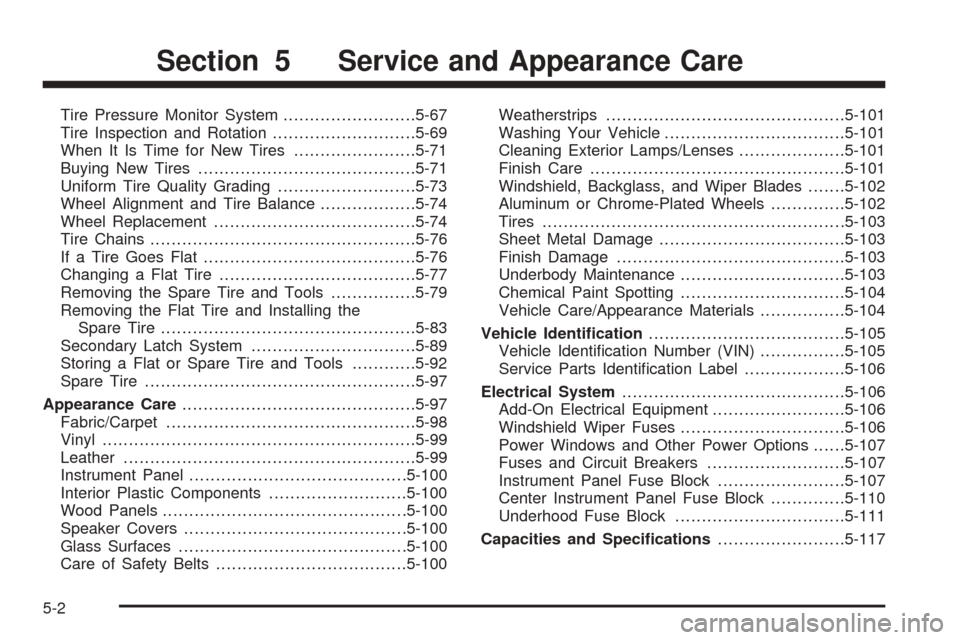
Tire Pressure Monitor System.........................5-67
Tire Inspection and Rotation...........................5-69
When It Is Time for New Tires.......................5-71
Buying New Tires.........................................5-71
Uniform Tire Quality Grading..........................5-73
Wheel Alignment and Tire Balance..................5-74
Wheel Replacement......................................5-74
Tire Chains..................................................5-76
If a Tire Goes Flat........................................5-76
Changing a Flat Tire.....................................5-77
Removing the Spare Tire and Tools................5-79
Removing the Flat Tire and Installing the
Spare Tire................................................5-83
Secondary Latch System...............................5-89
Storing a Flat or Spare Tire and Tools............5-92
Spare Tire...................................................5-97
Appearance Care............................................5-97
Fabric/Carpet...............................................5-98
Vinyl...........................................................5-99
Leather.......................................................5-99
Instrument Panel.........................................5-100
Interior Plastic Components..........................5-100
Wood Panels..............................................5-100
Speaker Covers..........................................5-100
Glass Surfaces...........................................5-100
Care of Safety Belts....................................5-100Weatherstrips.............................................5-101
Washing Your Vehicle..................................5-101
Cleaning Exterior Lamps/Lenses....................5-101
Finish Care................................................5-101
Windshield, Backglass, and Wiper Blades.......5-102
Aluminum or Chrome-Plated Wheels..............5-102
Tires.........................................................5-103
Sheet Metal Damage...................................5-103
Finish Damage...........................................5-103
Underbody Maintenance...............................5-103
Chemical Paint Spotting...............................5-104
Vehicle Care/Appearance Materials................5-104
Vehicle Identi�cation.....................................5-105
Vehicle Identi�cation Number (VIN)................5-105
Service Parts Identi�cation Label...................5-106
Electrical System..........................................5-106
Add-On Electrical Equipment.........................5-106
Windshield Wiper Fuses...............................5-106
Power Windows and Other Power Options......5-107
Fuses and Circuit Breakers..........................5-107
Instrument Panel Fuse Block........................5-107
Center Instrument Panel Fuse Block..............5-110
Underhood Fuse Block................................5-111
Capacities and Speci�cations........................5-117
Section 5 Service and Appearance Care
5-2
Page 320 of 470
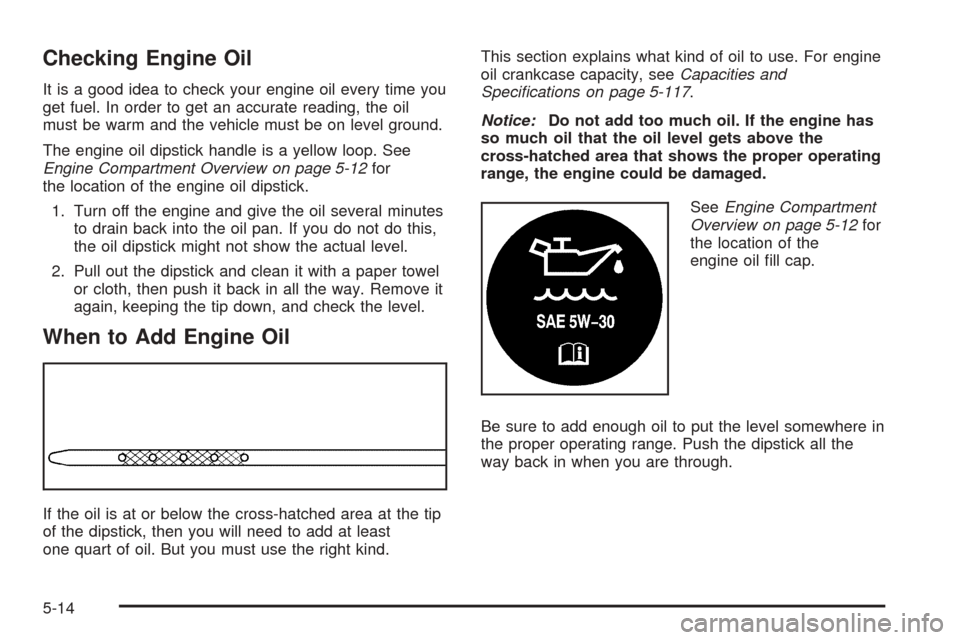
Checking Engine Oil
It is a good idea to check your engine oil every time you
get fuel. In order to get an accurate reading, the oil
must be warm and the vehicle must be on level ground.
The engine oil dipstick handle is a yellow loop. See
Engine Compartment Overview on page 5-12for
the location of the engine oil dipstick.
1. Turn off the engine and give the oil several minutes
to drain back into the oil pan. If you do not do this,
the oil dipstick might not show the actual level.
2. Pull out the dipstick and clean it with a paper towel
or cloth, then push it back in all the way. Remove it
again, keeping the tip down, and check the level.
When to Add Engine Oil
If the oil is at or below the cross-hatched area at the tip
of the dipstick, then you will need to add at least
one quart of oil. But you must use the right kind.This section explains what kind of oil to use. For engine
oil crankcase capacity, seeCapacities and
Speci�cations on page 5-117.
Notice:Do not add too much oil. If the engine has
so much oil that the oil level gets above the
cross-hatched area that shows the proper operating
range, the engine could be damaged.
SeeEngine Compartment
Overview on page 5-12for
the location of the
engine oil �ll cap.
Be sure to add enough oil to put the level somewhere in
the proper operating range. Push the dipstick all the
way back in when you are through.
5-14
Page 376 of 470
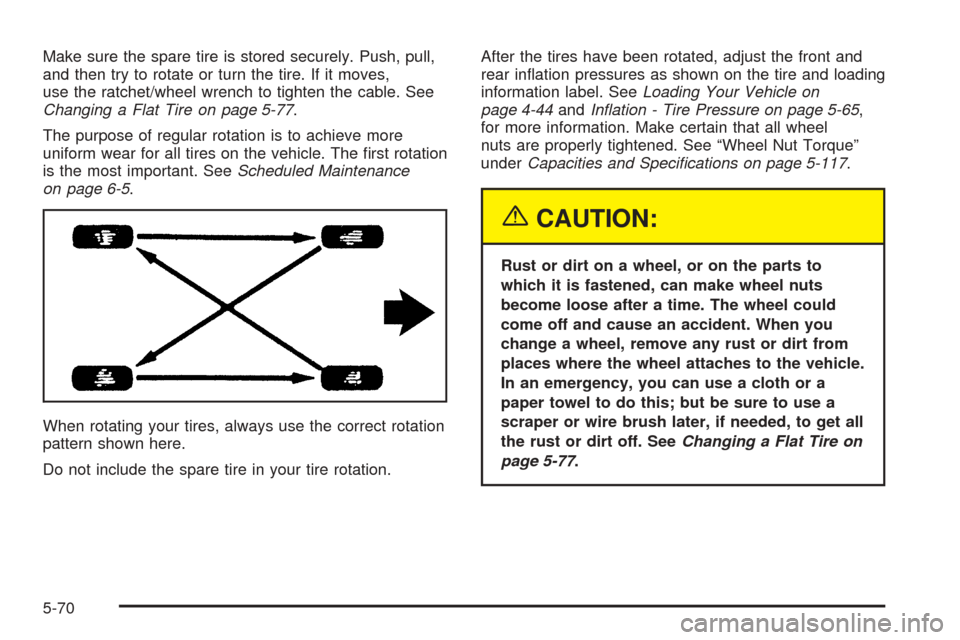
Make sure the spare tire is stored securely. Push, pull,
and then try to rotate or turn the tire. If it moves,
use the ratchet/wheel wrench to tighten the cable. See
Changing a Flat Tire on page 5-77.
The purpose of regular rotation is to achieve more
uniform wear for all tires on the vehicle. The �rst rotation
is the most important. SeeScheduled Maintenance
on page 6-5.
When rotating your tires, always use the correct rotation
pattern shown here.
Do not include the spare tire in your tire rotation.After the tires have been rotated, adjust the front and
rear in�ation pressures as shown on the tire and loading
information label. SeeLoading Your Vehicle on
page 4-44andIn�ation - Tire Pressure on page 5-65,
for more information. Make certain that all wheel
nuts are properly tightened. See “Wheel Nut Torque”
underCapacities and Speci�cations on page 5-117.
{CAUTION:
Rust or dirt on a wheel, or on the parts to
which it is fastened, can make wheel nuts
become loose after a time. The wheel could
come off and cause an accident. When you
change a wheel, remove any rust or dirt from
places where the wheel attaches to the vehicle.
In an emergency, you can use a cloth or a
paper towel to do this; but be sure to use a
scraper or wire brush later, if needed, to get all
the rust or dirt off. SeeChanging a Flat Tire on
page 5-77.
5-70
Page 394 of 470

8. Turn the wheel wrench counterclockwise to lower
the vehicle. Lower the jack completely.
{CAUTION:
Incorrect wheel nuts or improperly tightened
wheel nuts can cause the wheel to come loose
and even come off. This could lead to an
accident. Be sure to use the correct wheel
nuts. If you have to replace them, be sure to
get new GM original equipment wheel nuts.
Stop somewhere as soon as you can and have
the nuts tightened with a torque wrench to the
proper torque speci�cation. SeeCapacities
and Specifications on page 5-117for wheel nut
torque speci�cation.Notice:Improperly tightened wheel nuts can lead
to brake pulsation and rotor damage. To avoid
expensive brake repairs, evenly tighten the wheel
nuts in the proper sequence and to the proper
torque speci�cation. SeeCapacities and
Specifications on page 5-117for the wheel nut
torque speci�cation.
9. Tighten the nuts �rmly
in a crisscross
sequence as shown by
turning the wheel
wrench clockwise.
When you reinstall the regular wheel and tire, you must
also reinstall the center cap. Place the cap on the wheel
and tap it into place until it seats �ush with the wheel. The
cap only goes on one way. Be sure to line up the tab on
the center cap with the indentation on the wheel.
5-88
Page 423 of 470
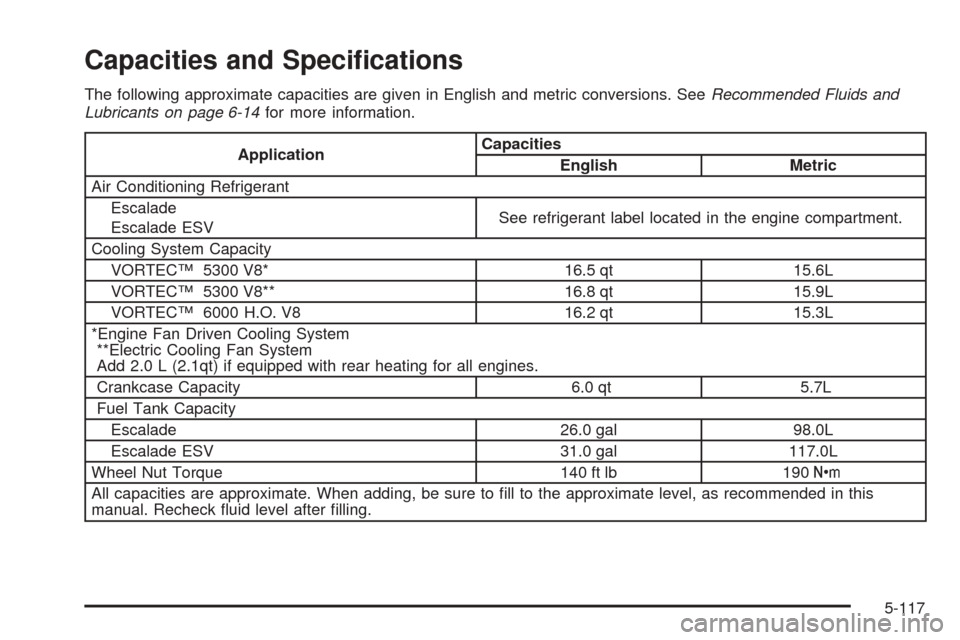
Capacities and Speci�cations
The following approximate capacities are given in English and metric conversions. SeeRecommended Fluids and
Lubricants on page 6-14for more information.
ApplicationCapacities
English Metric
Air Conditioning Refrigerant
Escalade
Escalade ESVSee refrigerant label located in the engine compartment.
Cooling System Capacity
VORTEC™ 5300 V8* 16.5 qt 15.6L
VORTEC™ 5300 V8** 16.8 qt 15.9L
VORTEC™ 6000 H.O. V8 16.2 qt 15.3L
*Engine Fan Driven Cooling System
**Electric Cooling Fan System
Add 2.0 L (2.1qt) if equipped with rear heating for all engines.
Crankcase Capacity 6.0 qt 5.7L
Fuel Tank Capacity
Escalade 26.0 gal 98.0L
Escalade ESV 31.0 gal 117.0L
Wheel Nut Torque 140 ft lb 190Y
All capacities are approximate. When adding, be sure to �ll to the approximate level, as recommended in this
manual. Recheck �uid level after �lling.
5-117
Page 458 of 470
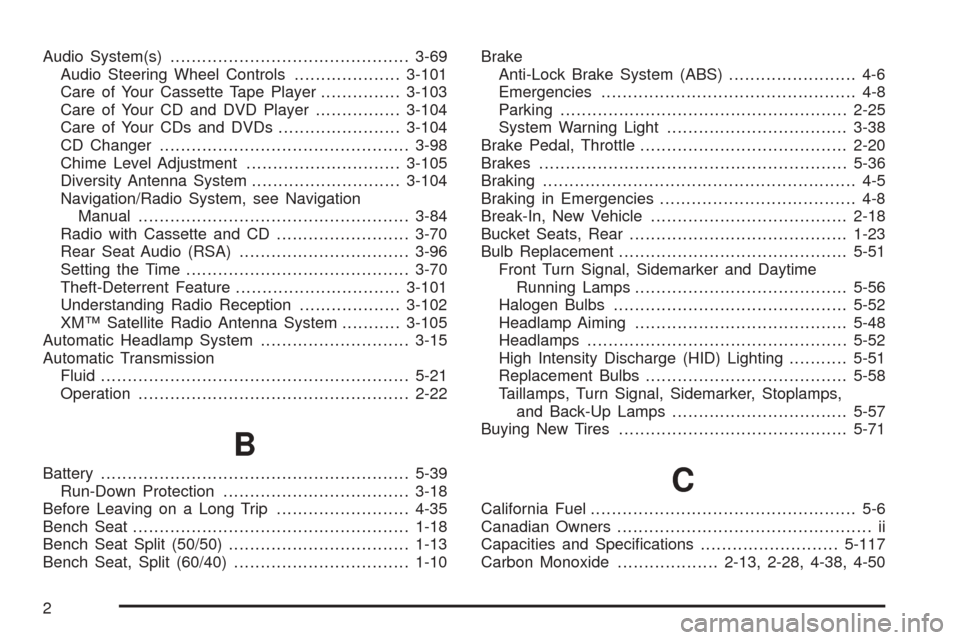
Audio System(s).............................................3-69
Audio Steering Wheel Controls....................3-101
Care of Your Cassette Tape Player...............3-103
Care of Your CD and DVD Player................3-104
Care of Your CDs and DVDs.......................3-104
CD Changer...............................................3-98
Chime Level Adjustment.............................3-105
Diversity Antenna System............................3-104
Navigation/Radio System, see Navigation
Manual...................................................3-84
Radio with Cassette and CD.........................3-70
Rear Seat Audio (RSA)................................3-96
Setting the Time..........................................3-70
Theft-Deterrent Feature...............................3-101
Understanding Radio Reception...................3-102
XM™ Satellite Radio Antenna System...........3-105
Automatic Headlamp System............................3-15
Automatic Transmission
Fluid..........................................................5-21
Operation...................................................2-22
B
Battery..........................................................5-39
Run-Down Protection...................................3-18
Before Leaving on a Long Trip.........................4-35
Bench Seat....................................................1-18
Bench Seat Split (50/50)..................................1-13
Bench Seat, Split (60/40).................................1-10Brake
Anti-Lock Brake System (ABS)........................ 4-6
Emergencies................................................ 4-8
Parking......................................................2-25
System Warning Light..................................3-38
Brake Pedal, Throttle.......................................2-20
Brakes..........................................................5-36
Braking........................................................... 4-5
Braking in Emergencies..................................... 4-8
Break-In, New Vehicle.....................................2-18
Bucket Seats, Rear.........................................1-23
Bulb Replacement...........................................5-51
Front Turn Signal, Sidemarker and Daytime
Running Lamps........................................5-56
Halogen Bulbs............................................5-52
Headlamp Aiming........................................5-48
Headlamps.................................................5-52
High Intensity Discharge (HID) Lighting...........5-51
Replacement Bulbs......................................5-58
Taillamps, Turn Signal, Sidemarker, Stoplamps,
and Back-Up Lamps.................................5-57
Buying New Tires...........................................5-71C
California Fuel.................................................. 5-6
Canadian Owners................................................ ii
Capacities and Speci�cations..........................5-117
Carbon Monoxide...................2-13, 2-28, 4-38, 4-50
2
Page 468 of 470

Service........................................................... 5-3
Adding Equipment to the Outside of
Your Vehicle.............................................. 5-5
Doing Your Own Work................................... 5-4
Engine Soon Light.......................................3-43
Publications Ordering Information...................7-11
Servicing Your Airbag-Equipped Vehicle..............1-84
Setting the Time.............................................3-70
Sheet Metal Damage.....................................5-103
Shifting Into Park (P).......................................2-26
Shifting Out of Park (P)...................................2-27
Signals, Turn and Lane-Change.......................... 3-7
Spare Tire.....................................................5-97
Installing....................................................5-83
Removing...................................................5-79
Storing.......................................................5-92
Speci�cations, Capacities...............................5-117
Speedometer..................................................3-33
Split Bench Seat (50/50)..................................1-13
Split Bench Seat (60/40)..................................1-10
StabiliTrak
®System.......................................... 4-8
Starting Your Engine.......................................2-19
Steering........................................................4-11
Steering Wheel Controls, Audio.......................3-101
Steering Wheel, Tilt Wheel................................. 3-6Storage Areas
Center Console Storage Area........................2-41
Convenience Net.........................................2-42
Cupholder(s)...............................................2-40
Glove Box..................................................2-40
Instrument Panel Storage Area......................2-41
Luggage Carrier..........................................2-41
Rear Seat Armrest.......................................2-42
Stuck in Sand, Mud, Ice or Snow......................4-42
Sun Visors.....................................................2-15
Sunroof.........................................................2-44
T
Tachometer....................................................3-33
Taillamps
Turn Signal, Sidemarker, Stoplamps, and
Back-Up Lamps.......................................5-57
Theft-Deterrent, Radio....................................3-101
Theft-Deterrent Systems...................................2-16
Content Theft-Deterrent................................2-16
Passlock
®...................................................2-17
Throttle, Adjustable..........................................2-20
Tilt Wheel........................................................ 3-6
12